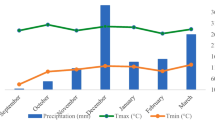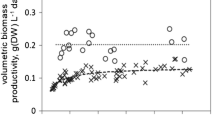Abstract
Two representative methods for quantitative estimation of soil algae, the culture dilution method and chlorophyll a extraction, were compared using soil samples collected from irrigation land in the flood plain of the River Ili, Kazakhstan, where the distribution of soil algae had been studied in the previous year. The estimate by the culture dilution method was almost the same as in the previous year, except for one site, which was enclosed by shrubs of sakusaul, Haloxylon aphyllum (Minkw.) Iljin. The important role of wind in transport of airborne algal cells was pointed out. There was a significant correlation (p<0.001) between the logarithm of the number of colonies by the culture dilution method andthe logarithm of the concentration of chlorophyll a, when data from all samples were analyzed. However, no significant correlation was observed with the data of cropland sites alone. Furthermore, the seasonal variations of both values at each site did not necessarily agree with each other. One reason for the inconsistency may have been the over estimation of chlorophyll a caused by inclusion of litter from vascular plants. Other reasons may relate to differences between the methodologies. The density of soil algae estimated by culture dilution reflects the algal biomass in a certain previous period of time. Therefore, it is suggested that the method is suitable for spatial, but not for seasonal studies.
Similar content being viewed by others
References
Azevedo MTP (1991) Edaphic blue-green algae from the São Paulo Botanical Garden, Brazil. Algological Studies 64: 503-526.
Bischoff HW, Bold HC (1963) Phycological Studies IV. Some soil algae from Enchanted Rock and related algal species. Univ. Texas Publ. No. 6318. 95 pp.
Bristol BM (1920) On the alga-flora of some desiccated English soils: an important factor in soil biology. Ann. Bot. 34: 35-81.
Broady PA (1979) Qualitative and quantitative observations on green and yellow-green algae in some English soils. Br. phycol. J. 14: 151-160.
Carson JL, Brown RM, Jr (1978) Studies of Hawaiian freshwater and soil algae II. Algal colonization and succession on a dated volcanic substrate. J. Phycol. 14: 171-178.
Coleman AW (1983) The roles of resting spores and akinetes in chlorophyte survival. In Fryxell GA (ed.), Survival Strategies of the Algae. Cambridge, New York: 1-21.
Dor I, Danin A (1996) Cyanobacterial desert crusts in the Dead Sea Valley, Israel. Algological Studies 83: 197-206.
Fogg GE, Stewart WDP, Fay P, Walsby AE (1973) The Blue-Green Algae. Academic Press, London, 459 pp.
Fujita Y, Nakahara H (1999) Seasonal variations of algal communities in the paddy water and air-dried paddy soil. Jap. J. Limnol. 60: 77-86. (Japanese with English abstract).
Grondin AE, Johansen JR (1995) Seasonal succession in a soil algal community associated with a beech-maple forest in northeastern Ohio, U.S.A. Nova Hedwigia 60: 1-12.
Hoffmann L (1989) Algae of terrestrial habitats. Bot. Rev. 55: 77-105.
Hunt ME, Floyd GL, Stout BB (1979) Soil algae in field and forest environments. Ecology 60: 362-375.
Johansen JR (1993) Cryptogamic crusts of semiarid and arid lands of North America. J. Phycol. 29: 140-147.
Johansen JR, Rushforth SR (1985) Cryptogamic soil crusts: seasonal variation in algal populations in the Tintic Mountains, Juab County, Utah. Great Basin Nat. 45: 14-21.
Kosaki T, Tsujimura S, Ishida N (1993) Where and how does salinization take place under large-scale irrigation agriculture in Central Asia? A case study in Kazakhstan. In: Proceedings of the International Workshop on Classification andManagement of Arid-Desert Soils. China Science and Technology Press, Beijing: 35-40.
Lukešová A (1993) Soil algae on four secondary successional stages on abandoned fields. Algological Studies 71: 81-102.
Lukešová A, Komárek J (1987) Succession of soil algae on dumps from strip coal-mining in the Most region (Czechoslovakia). Folia Geobot. Phytotax. 22: 355-362.
Pandey DC (1964) A study on the algae from paddy field soils of Ballia and Ghazipur districts of Uttar Pradesh, India. Part 1 Cultural and ecological considerations. Nova Hedwigia 9: 299-334.
Pipe AE, Cullimore DR (1980) An implanted slide technique for examining the effects of the herbicide diuron on soil algae. Bull. environ. Contam. Toxicol. 24: 306-312.
Quesada A, Fernández-Valiente E (1996) Relationship between abundance of N2-fixing cyanobacteria and environmental features of Spanish rice fields. Microb. Ecol. 32: 59-71.
Quesada A, Leganés F, Fernández-Valiente E (1997) Environmental factors controlling N2 fixation in Mediterranean rice fields. Microb. Ecol. 34: 39-48.
Reynaud PA, Roger PA (1977) Milieux sélectifs pour la numération des algues eucaryotes, procaryotes et fixatrices d'azote. Rev. Écol. Biol. Sol. 14: 421-428.
Roger PA, Reynaud PA (1976) Dynamique de lq population algale au cours d'un cycle de culture dans une rizière sahelienne. Rev. Écol. Biol. Sol. 13: 545-560.
Ruble RW, Davis JS (1988) Soil algae from fallow potato fields in south Florida (U.S.A.) marl. Nova Hedwigia 47: 403-414.
Schwabe GH (1972) Blue-green algae as pioneers on postvolcanic substrate (Surtsey/Iceland). In Desikachary TV (ed.), Taxonomy and Biology of Blue-green Algae. The Bangalore Press
Scor/Unesco (1966) Determination of photosynthetic pigments in seawater. Monographs on Oceanographic Methodology, 1.Unesco Publications Center, New York, 69 pp.
Shimmel SM, Darley WM (1985) Productivity and density of soil algae in an agricultural system. Ecology 66: 1439-1447.
Starks TL, Shubert LE (1982) Colonization and succession of algae and soil-algal interactions associated with disturbed areas. J. Phycol. 18: 99-107.
Sukala BL, Davis JS (1994) Algae from nonfertilized soils and from soils treated with fertilizers and lime of northcentral Florida. Nova Hedwigia 59: 33-46.
Tchan YT (1952) Study of soil algae. I. Fluorescence microscopy for the study of soil algae. Proc. Linn. Soc. N. S.W. 77: 265-269.
Tchan YT (1959) Study of soil algae. III. Bioassay of soil fertility by algae. Plant and Soil 10: 220-232.
Trainor FR, Gladych R (1995) Survival of algae in a desiccated soil: a 35-year study. Phycologia 34: 191-192.
Tsujimura S, Nakahara H, Kosaki T, Ishida N, Iskakov AR (1998) Distribution of soil algae in salinized irrigation land in the arid region of Central Asia. II. A case study of 25-year-old Bakbakty farm in the flood plain of the River Ili, Kazakstan. Soil Sci. Plant Nutr. 44: 67-76.
Tsujimura S, Nakahara H, Kosaki T, Ishida N, Karbozova E (1998) Distribution of soil algae in salinized irrigation land in the arid region of Central Asia. I. A case study of 14-year-old Bereke farm in the flood plain of the River Ili, Kazakstan. Soil Sci. Plant Nutr. 44: 53-65.
Whitton BA (1996) Cyanobacteria (Blue-Green Algae). In Hall GS (ed.), Methods for the Examination of Organismal Diversity in Soils and Sediments. CAB International in association with UNESCO and IUBS: 43-51.
Whitton BA (2000) Soils and rice-fields. In Whitton BA, Potts M (eds), Ecology of Cyanobacteria: Their Diversity in Time and Space. Kluwer Academic Publishers: 235-255.
Willson D, Forest HS (1957) An exploratory study on soil algae. Ecology 38: 309-313.
Zimmerman W, Metting B, Rayburn W (1980) The occurrence of blue-green algae in silt loams of Whitman County, Washington. Soil Sci. 130: 11-18.
Author information
Authors and Affiliations
Rights and permissions
About this article
Cite this article
Tsujimura, S., Nakahara, H. & Ishida, N. Estimation of soil algal biomass in salinized irrigation land: a comparison of culture dilution and chlorophyll a extraction methods. Journal of Applied Phycology 12, 1–8 (2000). https://doi.org/10.1023/A:1008126232188
Issue Date:
DOI: https://doi.org/10.1023/A:1008126232188




